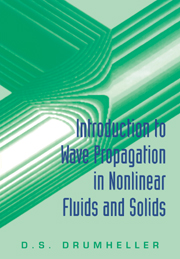Chapter 2 - Mechanical Waves
Published online by Cambridge University Press: 05 June 2012
Summary
The sea provides the most intuitive image we have of wave motion. As a wave passes, we notice that seaweed floating in the water moves slightly forward and then returns, and the motion of the wave seems only weakly connected to the motion of the water. Sometimes several waves merge into a single wave of much greater energy. The stronger wave travels at a slower speed, which allows other weaker waves behind it to catch up and add to its strength. Sometimes, these waves destroy ships at sea (see the opening quote of the preface). We know that wave motion causes changes in both the mechanical field and the thermal field, but much of what we know about wave motion in solids and fluids can be explained with a purely mechanical theory. In this chapter we study mechanical waves. To do this, we first define the elastic material. This material is described by a constitutive equation that only contains the mechanical variables associated with force and motion. We show that a linear-elastic material yields one type of solution called a linear wave. A nonlinear-elastic material yields a variety of solutions that include compression waves, rarefaction waves, and shock waves. To study these waves, we use the d'Alembert solution, the Riemann integral, the method of characteristics, the theory of singular surfaces, and the steady-wave solution.
Elastic Material
It is a common observation that individual materials react differently to applied loads.
- Type
- Chapter
- Information
- Publisher: Cambridge University PressPrint publication year: 1998



